Monday, August 18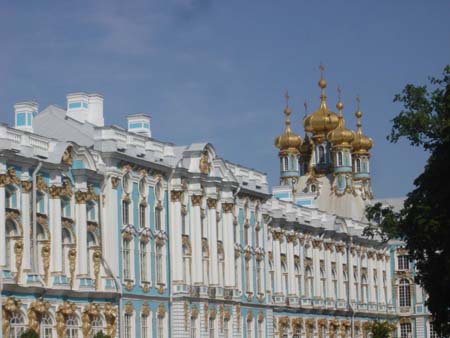
Paula: We enjoyed another busy day with Sasha, this time
in the towns of Pushkin and Pavlovsk. These are two towns about 30 minutes
south of St. Petersburg. Pushkin was built in the 1700s for Empresses Elizabeth
and Catherine. The main palace is large and dramatic, and is painted bright
turquoise blue with white and gold 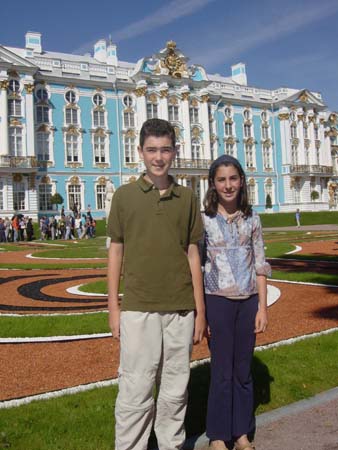 trim
on the exterior. It has four large gold baroque spires, and is surrounded
by lovely gardens and lakes. Sitting in the garden, we learned more Russian
history from Sasha and his notebooks and then visited Alexander Palace. This
is where Nicholas II lived and was arrested with his family just prior to
the Russian Revolution. We then flagged down a car to get us to Pavlovsk,
another town just 10 minutes further south and the site of the palace of Paul
I.
trim
on the exterior. It has four large gold baroque spires, and is surrounded
by lovely gardens and lakes. Sitting in the garden, we learned more Russian
history from Sasha and his notebooks and then visited Alexander Palace. This
is where Nicholas II lived and was arrested with his family just prior to
the Russian Revolution. We then flagged down a car to get us to Pavlovsk,
another town just 10 minutes further south and the site of the palace of Paul
I. 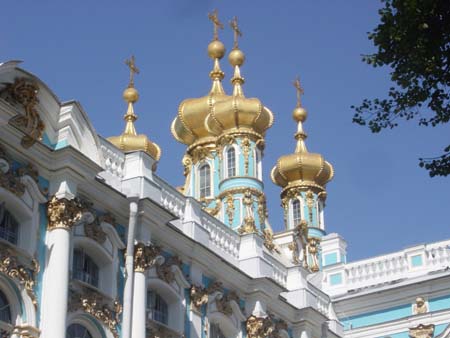
Pushkin and Pavlovsk were originally called Tsarskoe (Tsar's Village) until
they were renamed after the revolution. In Pavlovsk we decided to tour the
inside of the palace which was used as a royal residence. The palace was less
crowded and Sasha was able to give us a wonderful tour, sharing details of
the rooms and royal life. It was interesting to note that these palaces suffered
tremendous damage during WWII and were occupied by the German Army. The restoration
continues even today. When we asked Sasha about how the country has been able
to shoulder such a huge expense, he conferred with one of the babushkas, and
then answered: " by paying the workers low wages-paying artists like
they were plumbers." 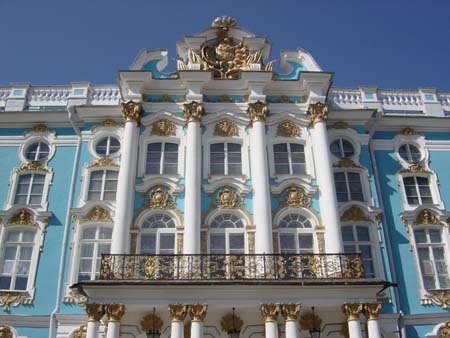
We also enjoyed a nice meal in Pavlovsk and discussed politics and the outlook of the Russian people with regard to its new Republic. Sasha appears to be very connected in the cultural and political life here in St. Petersburg. He is frequently stopped by people on the street (he seems to know everyone!) during our days with him and has spoken of his many conversations with high ranking individuals.
He shared with us an article he had published in a magazine here this summer.
He has also traveled outside of Russia, including two trips to the U.S., so
that he often shares his perspective on how the two countries differ. He is
anxious for the new Republic to operate as a full democracy but thinks that
people are still afraid to vote for more progressive candidates. He indicated
there are still a good number of older Russians who continue to want a return
to Socialism and that their voting block is still an issue. This makes it
difficult for the younger Russians to vote for the numerous progressive candidates,
for fear of splitting the vote of the mainstream Russians and risking a return
to Socialism. 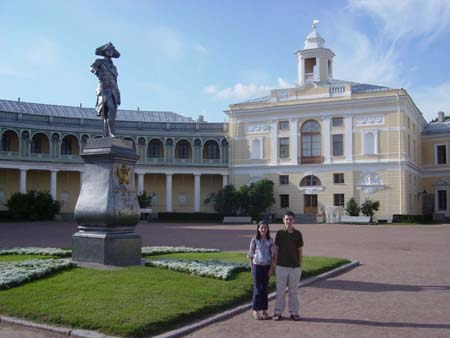
Sasha has frequently described how the older and younger Russians view life here. He describes the older generation as proud of their ability to "survive" despite little income and still wishing/hoping for the Return of the Socialist society. He describes the younger generation as the "New Russians" and full of optimism-stating "now that they can make money they feel they can do anything." He describes the group in the middle as ambivalent, wanting to embrace their children's dreams but feeling guilty about abandoning the Socialist ideal.
We rode our first Russian train back to St. Petersburg and Sasha took us through more of his notebooks with us on the train. The train station was also quite beautiful and we learned that the first railroad in Russia was built in the mid 1800s and traveled between Pushkin and St. Petersburg for the Czars. Before completing the day, Sasha helped us purchase train tickets to Moscow. We have decided to take the night train leaving St. Petersburg at 11:55 tomorrow night, arriving in Moscow at 8:00 the next morning.
Distance Walked: 4.22 miles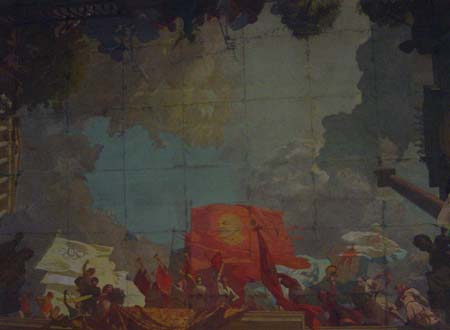
Steve: As a side note, at the train station Sasha pointed out the painting on the ceiling (pictured here). It contains one of the only images we've seen of Lenin in all of St. Petersburg (pretty interesting, especially considering that this city was called Leningrad up until 1992). The painting also used to have an image of Stalin, but that's been replaced with clouds. There are no images of Stalin left anywhere...
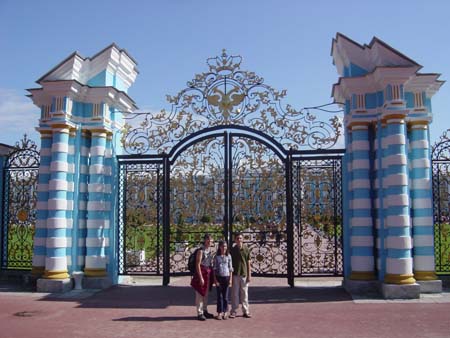
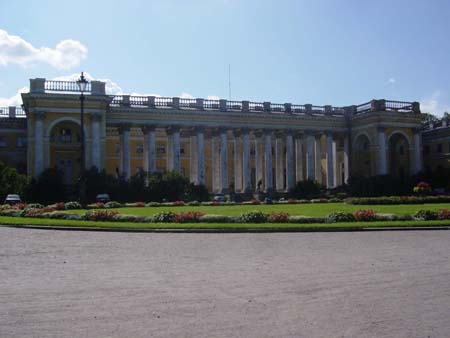
David: Transportation in St. Petersburg
Getting around in Russia has been an exciting, sometimes frightening, and
difficult adventure. Traveling, especially in St. Petersburg, has been like
nothing we've ever experienced before. We have used several means of transportation,
such as subways, taxi vans, trains, and buses. We have also seen motorcycles
and bikes on the streets, and small boats on the canals running through the
city. Subways, and cars are the two main types of public transportation in
Russia.
The Metro in St. Petersburg is very confusing, loud, and amazing. When you
first walk into a station, you must get a token. No one speaks any English,
so you just tell the cashier "four," but they don't even understand
that. You stick up four fingers, hand them money, and walk to the trains.
The most spectacular part of the subways is how deep they are. When you're
at the top, all you see is a long line of lights and people, but no bottom.
We timed how long it took on the escalator to get to the trains, which came
out to be two minutes and forty seconds (even going twice as fast as any escalator
in the States). The ride down the escalator is a big staring contest. The
Russians always have straight faces and never show any emotion. You stare
at each person going back up, trying to act like normal Russians. When you
finally get down to the trains, you have to pick which train you need to get
on. The Russian alphabet isn't the same as ours, so it's extremely hard to
read the signs. Dad just tells us the first two letters of the station we
are headed toward, and we then scavenge for it on the signs. Sometimes, if
we're not having a good day, two stations will start with the same two symbols,
and we end up taking the wrong train! Once we finally find the right train,
we have other things to worry about like pickpockets. There is usually at
least one pickpocket on each car! They also sometimes work in a group, which
means trouble. Getting seats are extremely rare, and the cars are usually
jam packed. The subway stops are very long, sometimes lasting up to five minutes.
Everyone inside the train wears dark clothes, and because of this we stick
out like a sore thumb. All the people stare at us like we were from another
planet. Occasionally venders get on the trains, and sell anything from newspapers
to CD's with the phone numbers of every citizen in St. Petersburg. One guy
was even selling a huge punching balloon that barely fit in the subway. Beggars,
bands, and war veterans also get on the trains asking for money.
Another form of main transportation is cars. Big vans, taxis, and ordinary cars are always roaming the streets. When we need to get somewhere we don't take the official taxis because they are very expensive. Our guide flags down an ordinary car on the street, and asks them to give us a ride for one to two dollars. Anything higher than that and he slams the door and flags down another. The cars he flags down are just ordinary Russian guys with old rundown cars. The driver's usually smoke, there are no seat belts, and they go really fast. We got really scared one night at about midnight when we found a couple of empty beer bottles in the car and lots of cigarettes. He drove in the middle of the road, on the tram tracks! The drivers don't speak any English, and we just hope that he understood our guide's directions. There are also big caravans roaming the streets looking for people to pick up. They usually cost forty cents per person, and we sometimes ride them for fifteen minutes. It's a good deal! We always look forward to seeing what kind of old car our guide brings us each morning to get to the Metro station.
Other types of transportation include trains (above ground), buses, motorcycles, and bikes. There are also taxi bicycles and horse drawn carriages. We are planning on taking a night train to Moscow at midnight from St. Petersburg.
